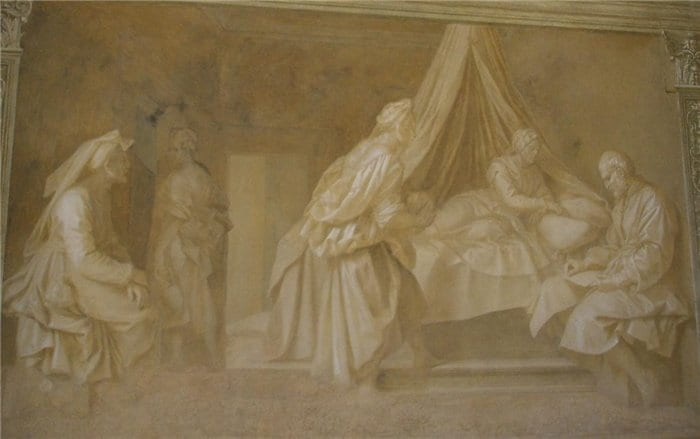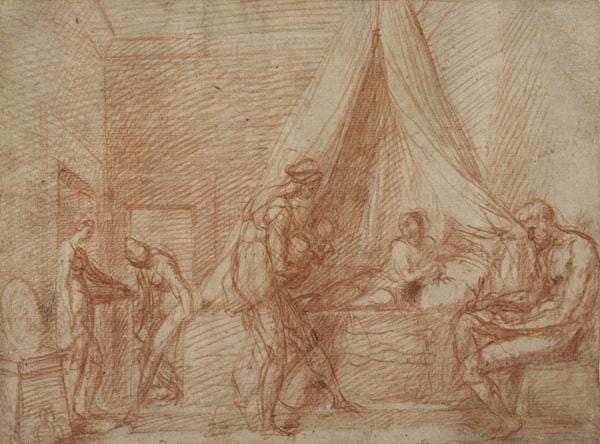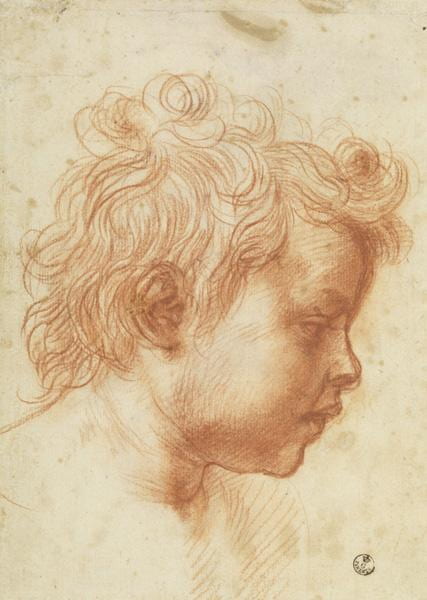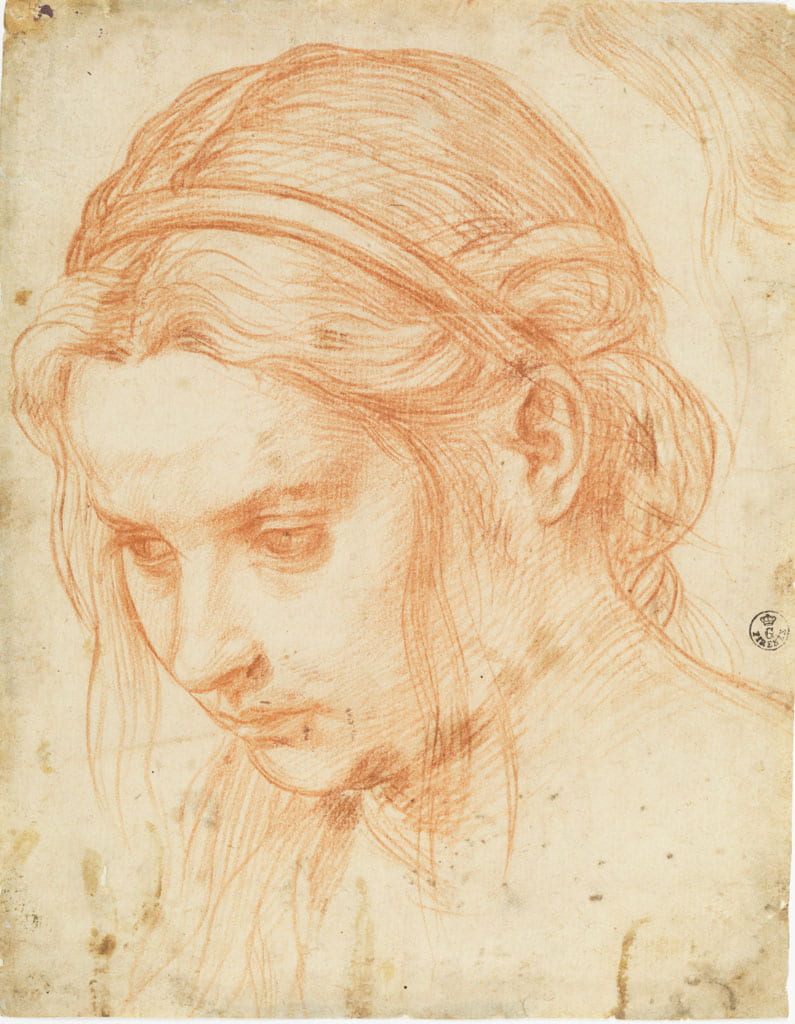by guest contributor Cynthia Houng
“So the point of my keeping a notebook has never been, nor is it now, to have a factual record of what I have been doing or thinking. That would be a different impulse entirely, an instinct for reality which I sometimes envy but do not possess.”
-Joan Didion, “On Keeping a Notebook.”
Drawing, much like keeping a notebook, is a way of thinking with the hand. Some drawings are quick dashes, glimmers caught in passing, or, as Didion put it, “bits of the mind’s string too short to use.” Others are more fully realized, pensées given weight and heft. Bodies emerge, out of tangled lines, becoming flesh. Figures acquire definite relationships to each other, and to space.

Study of Figures Behind a Balustrade (recto), about 1522, Andrea del Sarto, red chalk. The J. Paul Getty Museum
Andrea Del Sarto’s “Study of Figures Behind a Balustrade”is a record of this process of thinking with the hand. The drawing is a mixture of clarity and hesitation, speed and deferral—where Andrea could see clearly, he moved decisively, drawing firmly and cleanly. Certain passages of drapery, especially on the left-hand figure, were drawn in with a single stroke. Touch chalk to paper, and then move on. Other portions of the drawing clearly gave him trouble, for he returned again and again, layering line upon line. He labored over the right-hand figure, positioning the head in one way, and then another. Andrea, unconvinced by the first composition, sketched in an alternate position. We see how Andrea first sketched the figures as nudes, and then clothed them with draperies. Through the lines and hatch marks meant to indicate their vestments’ swags and draperies, the artist’s first thoughts—on how to render the body as a thing made of flesh and blood—remain poignantly visible. The page still feels something like an open box, offering up the traces of its own making, traces that would be erased, or masked, in the transition from thought to finished work.
The Andrea del Sarto drawings currently on view at the Frick Gallery for “Andrea del Sarto: The Renaissance Workshop in Action” span the range of drawing’s possibilities, from thoughts caught on the wing to full compositions. They feel revelatory, in their intimacy and their incompleteness. Their lack of finish conveys a vulnerability that is absent—or impossible—in a finished painting.

Birth of the Baptist. Chiostro dello Scalzo, Florence
Andrea’s grisaille fresco of The Birth of Saint John the Baptist (Florence, Chiostro dello Scalzo) depicts the moment when Elizabeth turns, in surprise, to look at her husband, Zacharias. Struck dumb at the beginning of Elizabeth’s pregnancy for his lack of faith—for when the Angel Gabriel visited Elizabeth and Zacharias with the news that she would bear a son, named John, Zacharias expressed his skepticism and fell mute–Zacharias regained his powers of speech at John’s birth. In the painting, Andrea gives us the moment when Zacharias writes “His name is John” on a tablet, and Elizabeth, startled by her husband’s voice, looks away from her newborn child and focuses her gaze on Zacharias instead. The painting is confident, precise, the composition is balanced and calm. Every gesture, every movement, is a given. It could be no other way.
The compositional drawing for this fresco, however, is full of second thoughts and revisions. The Andrea plays with different postures for each of the attendents. He reconsiders John’s posture. Elizabeth’s face is a blur of pentimenti. The decisive moment—Elizabeth turning to look at Zacharias, writing on the tablet—appears to have been a last-minute intervention. The drawing is a flurry of thought.

The Birth of Saint John the Baptist (Florence, Chiostro della scala). © The Trustees of the British Museum
Modern viewers find that openness and vulnerability immensely seductive. The intimacy of drawing resonates with our own notions of creativity and process. We treasure the psychological implications of this intimacy, the way that it brings us closer to the artist’s psyche. We love the draft more than the finished composition, for the draft reveals what the finished object hides—the pain and the pleasure inherent in the process of creation. It is a particular kind of romanticization, and one that suits our rapid-fire world, where the sense of living in flux mirrors more the manic motion of process than the impenetrable gloss and stillness of a highly-finished work.
In the Renaissance workshop, drawings were more than aesthetic objects. They were capital. Andrea saved and re-used his drawings, a practice in-line with the medieval tradition of keeping model-books or sketchbooks in the workshop. Both master and assistant relied upon existing sketches, models, and compositions throughout the process of making a new work, for these extant pensées saved labor. Instead of composing a whole new image, the artist could use an existing composition as a foundation, and through the process of lifting and reworking that image, transform it into something quite new.

This drawing was used in the composition process for the Bogherini Holy Family, which is currently on view at the Metropolitan Museum of Art. Head of an Infant in Profile to the Right, about 1527, Andrea del Sarto, red chalk. Gabinetto Disegni e Stampe, Gallerie degli Uffizi, Florence. Su concessione del Ministero dei beni e delle attività culturali e del turismo
In the catalogue that accompanies the exhibition, Julian Brooks (curator of drawings at the J. Paul Getty Museum, and one of the organizers of this show) noted that “the head featured [in this drawing] appears in no fewer than three compositions, as the infant Baptist in The Holy Family with Saint John the Baptist (St. Petersburg, Hermitage), and the Bogherini Holy Family (New York, Metropolitan Museum), and also as one of the three children in Charity (Washington D.C., National Gallery)” (40, 137). Drawings lingered around the workshop. They were used and re-used, as the basis for new compositions, as teaching aids, as cartoons (to be pricked and transferred onto a panel or canvas), as models and inspirations. They were valued both as traces of a particular hand, and as an essential part of the workshop’s daily practice.
The installation at the Frick takes us through all of these facets of Andrea del Sarto’s drawing practice. The lower galleries showcase the drawings. Moving from sheet to sheet, the viewer comes to know the Andrea’s hand. He favored black and, above all, red chalk, and in his hands, chalk could be made to yield tones and textures that were soft and fluid as smoke, or quick, crisp, and bright. The upper gallery highlights the relationship between the drawings and Andrea’s finished paintings.
One of the loveliest drawings in the show, a study of a young woman’s head, reveals Andrea’s mastery of this medium. The drawing is at once fragile and substantive. We feel the heft and weight of her existence in his modeling of her flesh, in the materiality of her headband. Andrea defined her cheek and neck with curving contour lines, so soft that we imagine the sensation of flesh yielding to the touch.

Study of the Head of a Young Woman, about 1523, Andrea del Sarto, red chalk. Gabinetto Disegni e Stampe, Gallerie degli Uffizi, Florence. Su concessione del Ministero dei beni e delle attività culturali e del turismo
Drawings never reproduce well, and chalk drawings reward viewers in specific ways. When we stand in front of these drawings, we can see how the grains of pigment cling to the paper’s rough tooth. In this drawing, we can see the lightness of Andrea’s touch, when he applied chalk to paper to give dimension and form to the young woman’s forehead, and observe how he softened his lines when he defined her eyes, smudging the lines so that they seemed to pool into smoky shadows. The drawing is a life study for the figure of Mary Magdalene in the Luco Pietà (Florence, Palazzo Pitti). Andrea painted this altarpiece in the plague year of 1523. It is a working drawing, part of the artist’s process of thinking through different problems of representation and composition, and it is more than that. Though drawn from life, she transcends it. Standing before her, almost five hundred years later—the past wings open, and we are once again in the middle of that plague year, somewhere in the countryside north of Florence, caught in the nexus of eye and hand and experience. The tenderness and fragility of the young woman’s face, framed by fallen wisps of hair, are counterbalanced by the soft solidity of her physical form. She is marmoreal, sculpted, and yet soft and breathing and full of life. The drawing is full of the grief of survival in a terrible time. I am here, and yet.
“Andrea del Sarto: The Renaissance Workshop in Action” is on view at the Frick Collection until January 10, 2016.
Cynthia Houng is a doctoral candidate in the History department at Princeton University. Her scholarly interests lie at the intersection of art history and economic history. Her dissertation examines relationships between connoisseurship, epistemology, and art and luxury markets in early modern Europe. She is interested in tracing the ways that shifting approaches to epistemology, aesthetics and economics—together with changing economic institutions and practices—shaped and reshaped regimes of value.



2 Pingbacks